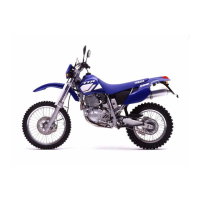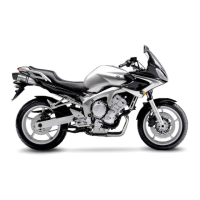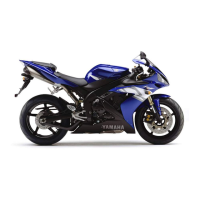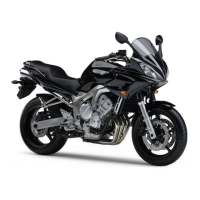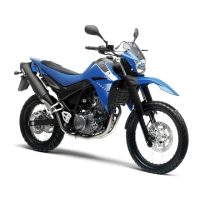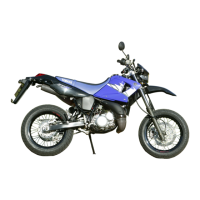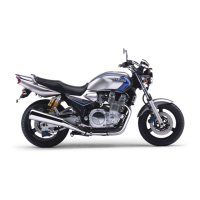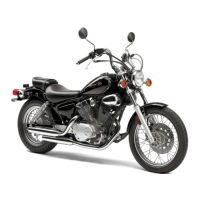
Do you have a question about the Yamaha 2004 TT600RE and is the answer not in the manual?
| Displacement | 595 cc |
|---|---|
| Compression Ratio | 8.5:1 |
| Fuel System | Carburetor |
| Ignition System | CDI |
| Starting System | Electric |
| Transmission | 5-speed |
| Final Drive | Chain |
| Front Suspension | Telescopic fork |
| Front Brake | Single disc |
| Rear Brake | Single disc |
| Front Tire | 90/90-21 |
| Ground Clearance | 300 mm |
| Engine Configuration | Single cylinder |
| Bore x Stroke | 95.0 mm x 84.0 mm |
| Rear Suspension | Swingarm |
Instructions on how to navigate and understand the service manual content.
Explanation of symbols used throughout the manual for identification and procedures.
Details on identifying the Yamaha TT600R motorcycle model and VIN.
Crucial guidelines for removal procedures, parts replacement, and general maintenance.
Procedures for inspecting and verifying electrical connections for proper function.
Listing of necessary specialized tools for maintenance and repair tasks.
Key specifications for the TT600R, including dimensions, engine, and basic data.
Detailed technical specifications for engine, chassis, and electrical components.
Standard torque values for fasteners and specific component tightening.
Table for converting metric unit data to imperial unit data.
Identification of lubrication points and recommended lubricant types for engine and chassis.
Diagrams illustrating the oil flow and lubrication system paths within the engine.
Diagrams showing the correct routing for various cables and hoses on the motorcycle.
Overview of the importance of periodic maintenance for reliable vehicle operation.
Schedule of recommended maintenance and lubrication tasks based on odometer readings.
Procedures for removing and installing the seat, fuel tank, and rear cowling components.
Detailed procedures for engine inspections and adjustments, including valve clearance.
Inspection and adjustment procedures for chassis components like brakes, forks, and steering.
Procedures for checking and maintaining the motorcycle's electrical system components.
Procedures for removing, disassembling, inspecting, and installing the front wheel and brake disc.
Detailed instructions for brake pad replacement, master cylinder, and caliper service.
Procedures for removing, disassembling, inspecting, and installing the rear wheel and brake disc.
Detailed instructions for rear brake pad replacement and master cylinder service.
Procedures for front fork removal, disassembly, oil replacement, and inspection.
Procedures for steering removal, inspection, and installation, including bearing adjustments.
Procedures for rear shock absorber removal, inspection, and adjustment of spring preload.
Procedures for swingarm removal, inspection, and lateral free play adjustment.
Procedures for drive chain, sprocket removal, inspection, lubrication, and installation.
Step-by-step instructions for removing the engine and related components from the motorcycle.
Detailed procedures for disassembling engine components like cylinder head, piston, and crankshaft.
Procedures for inspecting and repairing engine internal components such as cylinder head and valves.
Step-by-step instructions for assembling engine components and setting clearances.
Procedures for reassembling the engine after inspection or repair, following reverse removal steps.
Steps for safely removing the carburetor assembly from the motorcycle.
Technical data, torque values, and exploded views for carburetor components.
Cross-sectional diagrams illustrating the internal workings of the carburetor.
Detailed instructions for disassembling the primary and secondary carburetor units.
Procedures for inspecting carburetor components like jets, diaphragms, and valves for wear.
Step-by-step instructions for reassembling the carburetor after disassembly and cleaning.
Procedure for adjusting the fuel level in the carburetor while it is installed on the motorcycle.
Comprehensive wiring diagram illustrating the motorcycle's electrical system connections.
Legend explaining the color codes used for wires in the electrical diagrams.
Identification and location of major electrical components like battery, starter, and ignition.
Procedures for checking the continuity and function of various switches.
Procedures for inspecting and testing headlights, taillights, and indicator lights.
Detailed information on the ignition system, including circuit diagrams and diagnostics.
Information on the starting system, including circuit diagrams, operation, and diagnostics.
Information on the charging system, including circuit diagrams and diagnostics for battery charging issues.
Information on the light system, including circuit diagrams and diagnostics for lighting failures.
Information on the signalling system, including circuit diagrams and diagnostics for turn signals and horn.
Troubleshooting procedures for specific signal system controls like the horn and indicator switches.
Troubleshooting guide for starting issues related to fuel, electrical, and engine compression problems.
Troubleshooting steps for issues affecting the engine's performance at idle speed.
Troubleshooting guide for engine performance problems at medium to high speeds.
Troubleshooting steps for problems related to gear shifting, including impossible shifting and pedal issues.
Troubleshooting guide for clutch issues such as slipping or failure to release properly.
Troubleshooting steps for common brake system defects like poor braking performance.
Troubleshooting for oil leaks and malfunctions related to the front fork components.
Troubleshooting guide for issues causing unstable steering, related to various chassis components.
Troubleshooting for failures in lights, indicators, and other dashboard warning lights.
Troubleshooting guide for engine overheating issues related to ignition, fuel, and oil systems.
